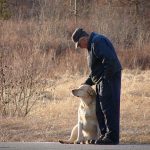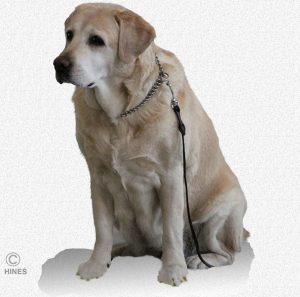Gastric Dilatation, Volvulus Or “Simple” Bloat: GDV, GD, FE
Ron Hines DVM PhD


There are dog owners, breeders and even veterinarians who use these three terms interchangeably. The symptoms are quite similar, but not what is occurring that produces them. Bloat just means an enlarged stomach or abdomen – distended with gas or food. In the least threatening examples, that might just meant that your dog ate too much, or perhaps consumed too much dry dog kibble, which later increased in volume when your dog subsequently drank water.
Although gastric dilatation (GD) could describe the same situation, veterinarians usually use that term to describe a situation where, for one reason or another, your dog’s stomach is having difficulty moving food farther along into its intestine.
Volvulus, also sometimes called Gastric Dilatation and Volvulus (GDV), is a situation where your dog’s stomach has flipped over on itself – much like a kinked garden hose – and is now blocking the normal entry and exit of food. It is the most serious of the three situations. It is life-threatening if it is not attended too promptly by your veterinarian. As pressure builds up in your dog’s trapped stomach, blood can no longer circulate normally through the stomach tissue, Cells are injured, toxins are liberated and dangerous changes in your dog’s blood composition occur. (read here & here)
Gastric Dilatation and Volvulus (GDV)
I am going to tell you more about gastric dilatation and volvulus (GDV) first, because it’s the most serious of the three and because it brings the largest number of worried readers to this page. GDV is one of the more common life-threatening condition that large and giant dog breeds face. Large breeds with deep narrow chests such as Great Danes and Borzois are at higher risk. (read here) Some veterinarians and dog breeders believe that the chances of GDV occurring in the lifetime of giant breed and large dogs is 24-47%. (read here) Others have estimated the likelihood at about half of that. Likelihood aside, when GDV strikes, it tends to be in your dog’s late-middle-age or senior years.
Veterinarians do not see a lot of gastric dilatation and volvulus cases – but when they do, they have to work diligently and rapidly if they are to save your dog’s life. Dilatation just means enlarged or stretched. A volvulus or torsion is a twisting or revolving of an organ around its longer axis – like a baggie half filled with water and suddenly flipped by the corners. In this sort of situation, the stomach rapidly expands with trapped air and fermentation gases that can no longer escape forward by your dog belching or pass rearward through the intestine and out the anus. In this stretched and often twisted condition, vital blood circulation to your dog’s stomach (and spleen) will soon be restricted or cut off. The massively enlarged stomach, pressing on your pet’s diaphragm, also restricts normal breathing.
Cases of only a gas filled, enlarged stomach (GD) without twisting do occasionally occur. In those situations, your veterinarian can find no evidence of a volvulus or torsion – only an inability (for reasons unknown) for your pet to move food and trapped gasses, now in its stomach, downstream into its intestines. That GD diagnosis is often made on the basis of your veterinarian still being able to easily pass a stomach tube down your dog’s throat and into its stomach and then confirm the tube’s correct placement using ultrasound or x-rays. In true GDV, the tube would encounter the “flipped over” stomach and find no entry.
What Signs Might I See When My Dog Is Experiencing GDV?
A classical case of GDV begins quite suddenly – often shortly after your dog consumed a large meal. The first signs you might notice in your dog are anxiety, restlessness and a disinterest in its usual routines. That is because of the abnormal fullness that is developing in its tummy, much as you would.
Many dogs begin to pant as their enlarging stomach presses on their diaphragm. They might look or lick at their abdomen, stand with their front legs wider apart, drool, salivate and make failed attempts to vomit, heave, or retch. At the most, foam and mucus is all that comes up. As time goes by, their abdomen continues to enlarge. It becomes tight and hard, usually causing them discomfort and pain. If these dogs are not brought to your veterinarian soon, the problem might progress to weakness, collapse and shock. That is why so many of these cases end up at urgent care 24-hour clinics. By that time, your dog’s gums are often pale, their pulse weak and rapid. Those are all classical signs of shock.
How Will My Veterinarian Know For Certain That This Is GDV?
Many problems can cause abdominal enlargement in dogs. But few, other than GDV, come on so suddenly and produce such severe signs. It is often the dog’s lower-left side (of its abdomen) that is most enlarged and firm. When dogs in this state are radiographed (x-rayed), their gas-filled, enlarged stomach is usually quite apparent. From the position of the gas bubble(s) within its stomach, your vet can often get a good idea if the stomach has flipped over into an abnormal position (a volvulus) or if it is just distended (simple bloat or dilatation). Read about simple food engorgement or FE at the bottom of this page. As I mentioned, the inability of stomach tubes, passed down the throat, to enter the stomach helps confirm a GDV problem.
As this problem progresses, laboratory examination of your dog’s blood often confirms metabolic acidosis. It is also common for blood potassium in these dogs to be low. Low blood potassium can affect your dog’s heart rhythm and cause muscle weakness. Blood plasma lactate levels are often increased too. The degree (amount) of elevation often parallels the severity of the case.
As I also mentioned, there are other diseases that can have similar symptoms to GDV. Your veterinarian will want to rule them out. One is under-performing adrenal glands (Addison’s disease). Various tumors, spleen or intestinal torsions (twists), intestinal obstructions, pancreatitis, hemorrhage, and diaphragmatic hernias might also need to be ruled out. (read here)
Is This An Emergency?
Yes, it is.
Time is of the essence in getting your dog to a veterinarian – preferably one with a large support staff of trained veterinary nurses and who deals with many emergencies. All owners of dog breeds in which GDV commonly occurs need to think ahead. Find out where the nearest 24-hour emergency animal hospitals are in your areas before you need them. Look into their reputations and cost structure. Then, tape their phone numbers onto your refrigerator. Enter them in your cell phone. Sudden weakness and discomfort in your dog – with no logical explanation – is always an emergency. The most important factor in the survival of dogs with GDV is the speed with which the problem is addressed.
The first job of your veterinarian will be to stabilize your pet’s circulatory system. That treatment often requires intravenous fluids and medications to counter shock. Supplemental oxygen might be required. If the gas pressure in your dog’s stomach cannot be relieved by other means, emergency surgery to return the dog’s stomach to its proper position is often required. But the chances of successful recovery from surgery are best when the dog’s general condition can be stabilized before the surgery begins. Often, attempts will be made during that surgery to prevent your dog’s stomach from ever shifting or twisting again. Read more about that procedure, called gastropexy, farther along in this article.
Why Did My Dog Develop GDV?
Veterinarians cannot explain that to you with certainty – even though we have observed the problem for more than 100 years. Much of what occurs in your dog’s abdomen relates to nerve signals that pass through the posterior branch of your dog’s vagus nerve. Whatever the underlying causes might be, most or all will probably involve that nerve. (read here) There are most likely many other factors that contribute to the problem. A deficiency in a hormone, motilin, might be a factor. (read here) As I mentioned earlier, your dog’s unique genetics play a part. (read here) Your dog’s body conformation is a factor – deep chested and large-bodied dogs are at greater risk. Your dog’s vagus nerve also stimulates your dog’s esophagus to rhythmically contract to convey food to its stomach. A hint that GDV is a vagus nerve problem is that the same breeds that suffer the most from GDV are the ones that suffer the most from megaesophagus. We also know that in most instances, the chances of GDV occurring increase according to your dog’s age. So does the decrease in the efficiency of your dog’s vagus nerve in performing its many important functions.
Gastropexy Surgery
When your veterinarian must perform surgery to get the twist out of your dog’s stomach and remove the gas and debris that are distending it, your veterinarian will almost certainly ask your permission to attempt to make it impossible for that problem to reoccur in the future. That surgical technique is called a gastropexy. Gastropexy involves creating a scar (a bond) between your dog’s stomach wall and its nearby abdominal wall. The technique used differs based on the preferences and training of your veterinarian. But all techniques remove the slick protective surfaces (the visceral peritoneum) from a small portion of your dog’s stomach, and a similar size area on its right abdominal wall. Bleeding surfaces, sutured together, will heal as one single unit. So, with time, your dog’s stomach will no longer slide around as freely in its abdomen as it once did. In critically ill dogs, irreparably damaged portions of the stomach and even its spleen might have to be removed as well. There are many surgical techniques.
One report suggested that greater than 80% of GDV dogs will experience a future, more serious, GDV event if a gastropexy is not performed. (read here) When tests and observation show that your dog is just too weak to tolerate the extended surgical time and effort required to perform the gastropexy, a second operation to so can be postponed until your dog is stronger. At that time, the gastropexy can often be performed through two much smaller incisions. Although thought of as an elderly dog problem, even young dogs occasionally require this surgery. (read here)
There are veterinary surgeons who suggest that all dogs of high-risk breeds receive a prophylactic (preventative) gastropexy. I believe that in most cases, that is an over-reaction. But do consider it when siblings or parents of your dog developed GDV while being fed and maintained in the ways the next paragraph suggests. When circumstances exist in your life that prevent you from supplying your dog a lifestyle that lowers GDV risk, you also might consider a prophylactic gastropexy for your pet. If your personality demands that the risk of GDV be close to zero, consider that surgery as well.
My Dog Is One Of The Breeds Prone To GDV – Are There Things I Can Do That Might Prevent It From Happening?
No one has found medications that are effective in preventing GDV, GD or simple Bloat in dogs. There has been work on developing drugs that promote stomach emptying (decrease gastric transit time) in humans. But the results have not been breathtaking. When some GDV cases have an element of pyloric valve spasm, some believe that sildenafil might be helpful. It appears to be in megaesophagus. I would be very hesitant to give a bloat-prone dogs that medication unless abnormally high pyloric valve tone had been adequately documented. (read here & here) It could do more harm than good.
I believe that the most important thing you can do to lessen the risk of GDV in your dog is to divide your dog’s daily food intake to multiple smaller meals throughout the day. Wild canines and ancient dogs were designed by Nature to engorge themselves whenever food was available – food might not come along again for quite some time. But that’s not how our dogs live today. Many of today’s dogs still retain that urge to eat more at one time than they should. At one time, up to the 1990s, US military dogs were fed once a day throughout. Among those dogs, GDV was the 5th most common cause of death. (read here) In government-owned experimental monkeys, once-a-day feeding commonly causes fatal bloat as well.
Some owners of GDV dogs describe their pets as greedy eaters. I do not know if that is generally true. There are even veterinarians who believe that it is possible that the weight of large meals eventually stretch the ligaments that normally prevent a dog’s stomach from “flipping” over (volvulus). Some stretching of that ligamental system also occurs during normal aging.
Other dog breeders believed that heavy exercise, just before or after eating can bring on GDV. I do not know if that is true either. Others have found that moderate exercise before and after meals was actually beneficial. (read here)
Many believe that a diet of dry dog chow is more likely to produce GDV than a diet of fresh or canned food. Dogs tend to drink a large amount of water subsequent to consuming dry kibble. The kibble swells and the stomach inflates. That is probably more likely to cause the “simple bloat” discussed at the end of this article than GDV. But I cannot tell you that with certainty either.
A Purdue University study suggested that feeding your dog from a raised bowl increased its chances of developing GDV. Most folks who feed their dogs from elevated dishes, do so to treat or prevent of megaesophagus/swallowing issues. Since GDV and megaesophagus have the same autonomic nerve dysfunction as their underlying cause, I doubt that the raised bowls were the true cause of GDV.
Others have found that having fats or oils within the first four ingredients listed on a dry dog food label appeared to increase the chances of GDV in dogs. (read here) Dietary fat is thought to slow stomach emptying. Studies in laboratory animals tend to back that up. (read here & here) So I would feed my GDV-prone dog a lower fat diet. How the fiber content of your dog’s diet affects its gastric emptying time remains unknown.
“Simple” Bloat – Food Engorgement – Food Bloat
It doesn’t take the complex issues I have been discussing until now to cause your dog’s stomach to become too full. Simple gluttony plus the swell-potential of the things dogs eat are sufficient to cause a severe tummy ache – or worse. Dry dog chow is only 6-10% water. The natural diet of canines, lean meat, is about 80% water. When your dog fills his or her stomach with dry kibble and then drinks water, that dry kibble is going to expand considerably. Food engorgement is also a common condition of puppies.
You are on the Vetspace animal health website
Visiting the products that you see displayed on this website help pay the cost of keeping these articles on the Internet.

